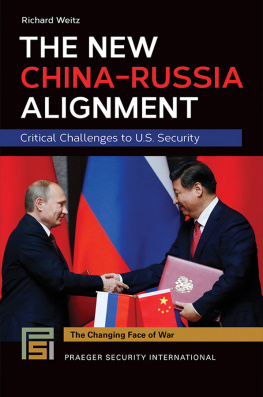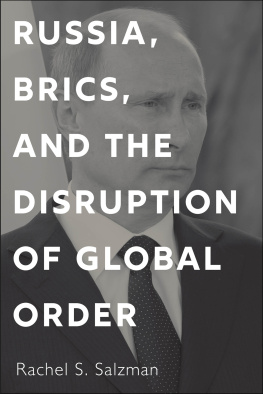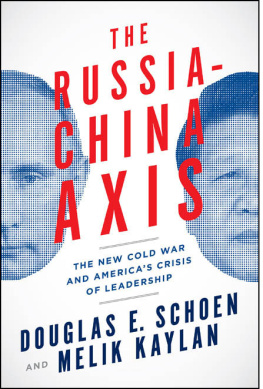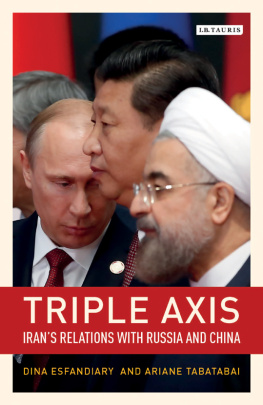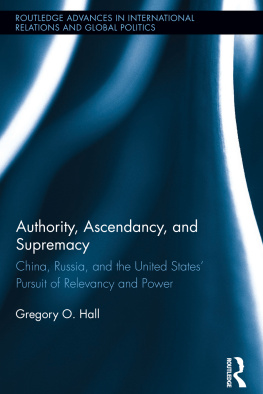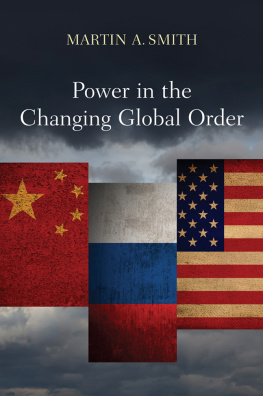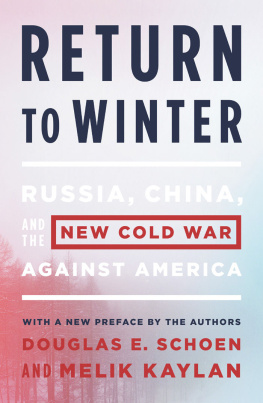The New China-Russia Alignment
Recent Titles in
The Changing Face of War
Mismanaging Mayhem: How Washington Responds to Crisis
James Jay Carafano and Richard Weitz, editors
Private Sector, Public Wars: Contractors in Combat Afghanistan, Iraq, and Future Conflicts
James Jay Carafano
Fighting Identity: Sacred War and World Change
Michael Vlahos
The Three Images of Ethnic War
Querine Hanlon
Spying in America in the Post 9/11 World: Domestic Threat and the Need for Change
Ronald A. Marks
The Future Faces of War: Population and National Security
Jennifer Dabbs Sciubba
War and Governance: International Security in a Changing World Order
Richard Weitz
Cyber Warfare: How Conflicts in Cyberspace Are Challenging America and Changing the World
Paul Rosenzweig
Rebuilding American Military Power in the Pacific: A 21st-Century Strategy
Robbin Laird, Edward Timperlake, and Richard Weitz
Cyber Dragon: Inside Chinas Information Warfare and Cyber Operations
Dean Cheng
The New China-Russia Alignment
Critical Challenges to U.S. Security
Richard Weitz
The Changing Face of War
James Jay Carafano, Series Editor

Copyright 2022 by Richard Weitz
All rights reserved. No part of this publication may be reproduced, stored in a retrieval system, or transmitted, in any form or by any means, electronic, mechanical, photocopying, recording, or otherwise, except for the inclusion of brief quotations in a review, without prior permission in writing from the publisher.
Library of Congress Cataloging-in-Publication Data
Names: Weitz, Richard, author.
Title: The new China-Russia alignment : critical challenges to U.S. security / Richard Weitz.
Other titles: Critical challenges to U.S. security
Description: Santa Barbara : Praeger, An Imprint of ABC-CLIO, LLC, [2022] | Series: The changing face of war | Includes bibliographical references and index.
Identifiers: LCCN 2022006719 (print) | LCCN 2022006720 (ebook) | ISBN 9781440847363 (hardcover) | ISBN 9781440847370 (ebook)
Subjects: LCSH: United StatesRelationsChina. | United StatesRelations Russia (Federation) | ChinaRelationsUnited States. | ChinaRelations Russia (Federation) | Russia (Federation)RelationsUnited States. | Russia (Federation)RelationsChina. | United StatesForeign relations 21st century. | National securityUnited States.
Classification: LCC E183.8.C6 W45 2022 (print) | LCC E183.8.C6 (ebook) | DDC 327.73051dc23/eng/20220210
LC record available at https://lccn.loc.gov/2022006719
LC ebook record available at https://lccn.loc.gov/2022006720
ISBN: 978-1-4408-4736-3 (print)
978-1-4408-4737-0 (ebook)
26 25 24 23 221 2 3 4 5
This book is also available as an eBook.
Praeger
An Imprint of ABC-CLIO, LLC
ABC-CLIO, LLC
147 Castilian Drive
Santa Barbara, California 93117
www.abc-clio.com
This book is printed on acid-free paper 
Manufactured in the United States of America
Contents
This volume examines the unprecedented alignment between the Russian Federation and the Peoples Republic of China (PRC) that has developed in recent years. It analyzes the main drivers of the Sino-Russian relationshipits sources, nuances, and manifestations in detailand assesses its consequences, especially for the United States. Over the past three decades, Moscow and Beijing have moved increasingly close in critical security, economic, and regional areas. They have pursued harmonious regional policies toward the Korean Peninsula, Central Asia, and the Middle East while better institutionalizing and integrating their security ties. China has become Russias leading national trade partner, gateway to other Asian markets, and an important energy importer. The leaders of both countries have engaged in numerous high-level exchanges, made many mutually supportive statements, and manifested other dimensions of their developing strategic partnership. Both regimes view their improved ties as a tremendous success that they must sustain. Their nonconfrontational relationship benefits both countries. Russian leaders can focus on advancing their interests in the former Soviet republics, Europe, and the Middle East, while Beijing can pursue primacy in the Indo-Pacific region. Shared opposition to the United States and its values partly explains their tightening ties. As a result, Moscow and Beijing have adopted coordinated as well as separate policies to counter U.S. power and influence.
The Sino-Russian relationship has moved considerably closer than many expected in recent years. Scholars have traditionally downplayed the potential for an enduring and comprehensive Russia-China alignment against the United States. Many analysts have argued that Sino-Russian cooperation is constrained by the two countries interest in sustaining favorable ties with the United States and the relatively benign nature of U.S. hegemony, which provides many benefits to Russia and the PRC. It was thought that Moscows and Beijings centuries-long history of conflict and distrust as well as Russias and Chinas strong capacity to defend against external military threats presented additional barriers. Until recently, the concept of triangular diplomacy has been out of fashion in Washington. Whereas Russian and Chinese writers have regularly employed a triangular framework in their discourse on great power politics, most U.S. foreign policies have typically addressed each country separately rather than considering their combined weight. For many years after the end of the Cold War, U.S. national security decision makers rarely considered how U.S. dealings with Moscow or Beijing would affect the Sino-Russian alignment, let alone what tactics Washington could use to shape the relationship. In contrast, Russian and Chinese policies have striven to exploit U.S. tensions with the other state. Prudence warrants more consideration of the effects an enduring Sino-Russian alignment could have on the United States. Not only do strong Russian-Chinese ties look likely to persist for years, and they could plausibly broaden and deepen this alignment in the future, but Russia and China have also already experienced an impressive geopolitical resurgence since the Cold War. U.S. policy makers need to acknowledge and understand how U.S. decisions and other factors impact Sino-Russian ties. At a minimum, U.S. policy makers should make a greater effort to assess how Russian-Chinese collaboration presents a more challenging environment for U.S. foreign policy. Even better, U.S. leaders could try to redirect the relationship in ways that benefit U.S. interests. Toward that end, this manuscript examines several complementary case studies encompassing geographic and functional issues that are critically important for all three countries. These cases reveal various pathways, events, and drivers that have most impacted the dynamics shaping the Russia-China relationship.
The first part of this book reviews the changing nature of Sino-Russian ties since the Cold War, focusing on their governments strengthening connections and increasingly anti-American worldviews. The Russian and PRC political systems have become more similar under their current national leaderships. Since the end of the Cold War, both governments have become more authoritarian under preeminent leaders who dominate national policies. Neither country tries to export its authoritarian ideology as ardently as their Cold Warera predecessors, who adhered to (and fought over) Marxist-Leninist principles. Yet, both governments have become less tolerant of domestic and international opposition. Since becoming Russias president in 2000, Vladimir Putin has suppressed the limited political and economic pluralism that arose during the presidency of his weaker predecessor, Boris Yeltsin. The PRC had been moving in a more politically liberal direction in the late 1990s, with previously rigorous controls slightly loosened, while the ruling Chinese Communist Party (CCP) maintained the requirement for a more collective leadership and the obligatory rotation of political elites. After Xi Jinping became the countrys paramount leader, however, the PRC became even more authoritarian. In 2018, the CCP National Party Congress abolished the two-term limit (i.e., two periods of five years) on presidential terms, while Xi has assumed a cult of personality, and Chinese censorship, drawing on technological advances, has become more severe. Xi is scheduled to remain Chinas unelected president until 2022, while Putins presidency extends until 2024, but both presidents seem able to extend their limits indefinitely. Along with other members of governing elites in both Moscow and Beijing, the presidents display resolute ideological opposition to Western values. They view U.S. professions of promoting democracy and human rights as a conceptual guise to subvert their regimes and those of their allies while advancing U.S. commercial and strategic interests. They vehemently insist that the United States and other foreign governments should respect traditional interpretations of state sovereignty, territorial integrity, and national autonomywhich includes nonintervention in their internal affairs. At the same time, both regimes violate these principles in their foreign policies while employing nationalism and anti-Americanism to rally domestic support behind their policies. They emphatically oppose U.S. interference in their perceived regional spheres of influence, especially Washingtons siding with their neighbors in their disputes with Beijing and Moscow.

